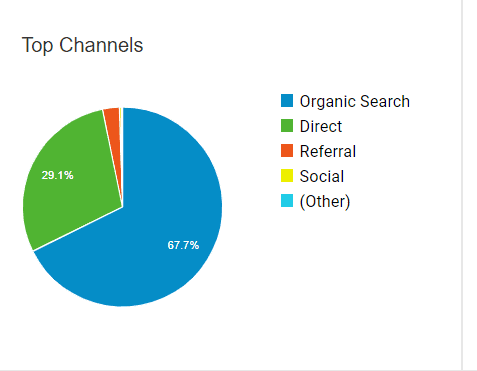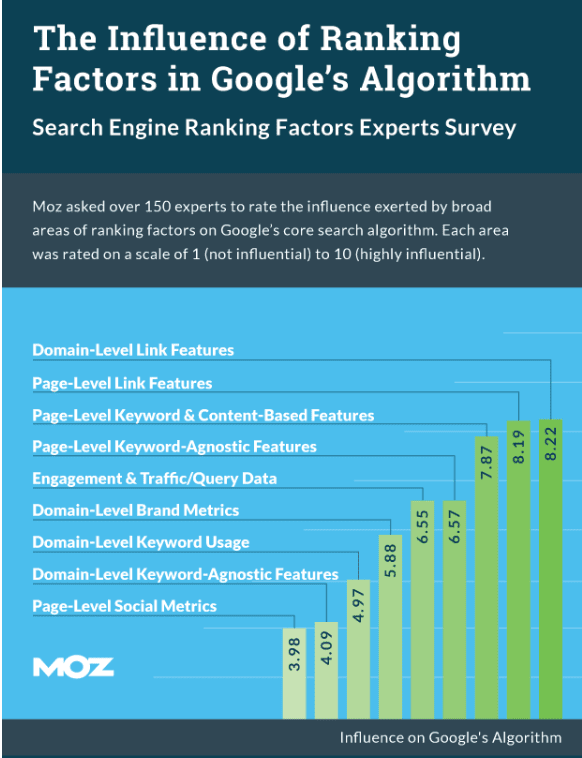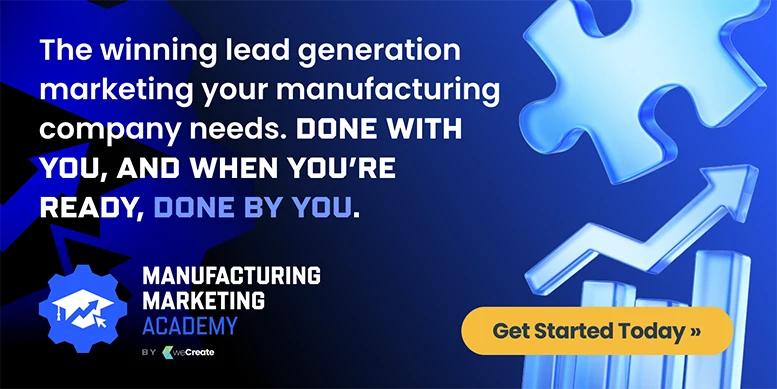SEO for Manufacturing Companies in 2025

Table of Contents
- What happens if you don’t do SEO
1.1 Organic Traffic Versus other sources
1.2 Organic Traffic with Paid Campaign and other sources
1.3 Word of caution to busy manufacturers who don’t care about marketing - How does SEO work for manufacturing companies
2.1 Keyword examples
2.2 Tracking results - Fundamental Techniques of SEO
3.1 Technical ranking factors chart
3.2 The most important ranking factors - Constructing a powerful page of SEO content
4.1 SEO Keyword Areas
4.2 Keyword Selection and Page Length - Backlinks and Website Authority/Off-page SEO
5.1 How to find backlinks
5.2 Free Backlink opportunities - Summary of SEO for Manufacturing Companies and FAQs
6.1 More SEO Resources
What is SEO For Manufacturing Companies?
SEO for manufacturing companies is a service or activity that improves the presence of and traffic to a manufacturer’s website in search engines through increased keyword ranking. The two core fundamentals of SEO are:
- Determining the keywords your target market will search, and building pages or posts of content around those keywords
- Building the authority of your website through backlinks and brand mentions.
1. What Happens if You Don’t Do SEO?
Manufacturers commonly say that they are bursting at the seams with work so they are not prepared to focus on SEO or generate new leads. While those manufacturers are not the primary focus of this article, it’s important to issue a word of caution to those manufacturers. While there is not a lot of outside thorough research on the subject, we did a small study of 30 manufacturers we work with and found that:
80% of new manufacturer leads were coming through digital marketing like SEO
20% were coming from word of mouth, trade shows, or traditional advertising (this number is reducing consistently over time, as younger generations move into procurement positions).
1.1 Traffic and lead sources for manufacturers in our research group
If you analyze this fairly typical traffic breakdown from a manufacturer that is very active with search engine optimization, these percentages make sense:

Organic search represents the largest percentage of site visitors and the largest percentage of conversions or rfq form fill outs. Referral, would also be included in the SEO efforts, since these referral visitors came from backlinks that were built. The 29.1% direct (people that put the website address directly into the browser) can be split into a couple categories.
- Individuals that were already working with the company or found them through offline advertising and needed to contact them or find additional information
- Individuals that had already found them through organic search results and went back later through a direct browser search
The majority of companies we asked who had performed no digital marketing and had an antiquated or non-existent website, said they were generating virtually zero leads and were relying on long term customers for revenue.
1.2 Here is another example:

The manufacturer whose website traffic is related to above, was performing paid search (Google Ads) in addition to SEO. Paid search tends to “cannibalize” traffic, which means that when someone does a direct search or a keyword search, they will click on the first listing they see, even if the organic listing is just below it. If you adjust for that effect, you will see a very similar result to the first company chart.
1.3 Back to the word of caution if you are a manufacturer who has too much business and too few employees
Just because things are great now, doesn’t mean that the inevitable economic downturn (they happen about every 3.5 years) won’t affect your business. Wouldn’t you rather be in a position where you are turning down business or outsourcing it for smaller profit margin while things are great, so that you are still receiving leads and new business when things aren’t economically great? While this should not have to even be stated, many manufacturers are more than happy to put their head in the sand and wait until things get really bad before they take action to improve their marketing. One thing is for certain: Manufacturers that have a great website which states their value proposition clearly, and who perform SEO get consistent leads.
2. How Does SEO Work for Manufacturing Companies?
2.1 SEO Premise and Keyword Examples
SEO begins with an assumption (that is also a fact), that for any given manufacturing service, there are individuals looking for a qualified provider through search engines. Here are some examples we pulled directly from real data sources including Google Search Console:
“Contract machine shop in Illinois”
“ISO Certified Die Caster”
“Heavy fabrication services”
“Bronze casting company”
“Injection Molding manufacturer near me”
2.2 Tracking and Proof
Each one of these terms receives hundreds or thousands of searches nationwide every month, and each one of these terms is primarily being searched by an individual that is in the market for the services they searched for. How do we know this? The easiest way to explain it is that when we perform SEO, we use Google Analytics to track conversion goals. An example of a goal would be: When a person on my “iron forging” page completes an RFQ form fill, track a conversion. We can then track where the individual who found the iron forging page and filled out the form came from (organic search, direct, social, paid search). At this point we clearly know that our efforts to rank the company for “Iron Forging Manufacturer” directly contributed to that new lead.
It is impossible to overstate the power of SEO for manufacturing companies
As stated before, prior to developing a new website, and performing on-going search engine optimization, the vast majority of companies we work with were not receiving new leads, or very rarely.
3. What are the fundamental techniques in SEO?
3.1 Technical Ranking Factors
If you happened to Google the search term “SEO for Manufacturing companies” you will have seen that there are a hundred different articles that speak on the subject. Most of them give a huge breakdown of technical terms which probably lead the reader to feel as if it would be impossible to do anything on your own to improve SEO, but that’s just not true. Here are some of the commonly used terms that you’ll see as stated by Moz.com:

While Moz conducts a great study across the industry and they are very right in their metrics, you can forget all about this! If you remember two important concepts, you will be able to encompass 90% of what is listed in the chart above without all the technical jargon.
3.2 The Two Most Important Concepts in SEO Are:
The two accompanying short videos were filmed live at a training event for manufacturing marketers
Content
Backlinks
While it is marginally possible to rank content without backlinks, it is impossible to rank for keywords without content, so lets start with that.
4. How to Construct Fantastic Pages of SEO Content.
First let’s look at a page of content from Google’s perspective. In order to tell what your page is about, Google bots need to see the keywords you want the page to rank for. There are a number of important places the bots are going to look. Below, you’ll see the areas from the front end or consumer facing view. In order to access these on your website (assuming you are using a modern content management system like WordPress or Webflow, you will need to log in, and use an SEO tool like SEO Yoast (most of the time this is very simple for even low-techies). These are listed in order of priority for your keywords:
4.1 SEO Areas for keywords
1. Your SEO Title
Where it shows:

Your SEO title shows in one more place, actually in search results after a term is Googled like “how to find customers for machine shops”

2. Your Meta Description which you’ll also find in the back end of your website once you log in and use a tool like Yoast. The meta description is visible in search results directly below your SEO title:

3. Your Page Heading. This is usually the largest text on your page and should have an “H1” tag

4. Your content
After you select the correct keyword set and place that exact keyword set into your SEO title, Meta Description, and Heading, the last thing you need to do is write a page or article that contains that keyword set 4 or 5 times. You can use variations of the keyword – for example: “how to find customers for machine shops” could be restated like “ways to get customers for machine shops” – but make sure you have the exact match keyword at least 3 times. The length of your content should be at the very least 500 words, but for many competitive topics, you may need to expand that to a thousand or more words.
4.2 Selection of keywords to place in your important SEO areas
Keyword selection is the most important part of on-page SEO or content writing. If you select the wrong keyword, it could be too competitive for you to ever rank, or it may not be what your target customer is actually searching for. Here is a quick guide to selecting the right keywords:
- Identify the service you want to rank for. For example, if you provide machining services, you may want to rank for the term “contract machine shop”.
- Evaluate your competition. Google the term you want to rank for, and see how many websites on the first page use that exact match keyword in their SEO title, Meta, and on-page content. If there are many of them, and you are just starting SEO, chances are, you will not have the website authority (covered below) to rank for that keyword set. Try to choose keywords that are likely to be searched, and find gaps in content with your competition.
- Get in the mind of your target customer. For example, if you are that same machine shop and you want more aerospace work, realize that aerospace OEMs are not going to google “aerospace machining work” although that’s what many machine shops will put in their SEO titles. The aerospace OEM will be looking for “Machine shops with AS9100 Certification” as one example.
Backlinks for manufacturers are simply a link from another website that points to your website. For example, if you were a member of your local manufacturer’s association and they had a listing for all of their members with links to member websites, that would be a backlinks. The reason why having exact match content is not enough to rank in most cases is that there are going to be many other websites that have pages dedicated to the same keywords. Google needs off-page SEO metrics, also known as Authority, which comes from backlinks, to determine which site is the most credible result to display. This makes a lot of sense because these backlinks are votes of credibility for your company. After all, if a credible organization like the manufacturers association is linking to your site, it must mean something right?
5.1 How to find backlinks for your company
Backlink building is one of the more difficult tasks for most novices because there are many different ways to find them, and they aren’t all equal. Each website has its own authority, so you need a way to measure that authority before you go through all of the trouble to get the backlink. In general there are two ways we find backlinks for manufacturers:
- Evaluate your relationships in the industry. Are there any organizations you have joined or could join to get a backlink? Do you have dedicated suppliers or partners that have an area on their site where it would make sense to link to you (think testimonials, or partners pages)?
- Perform competitor research. You can use a tool like Moz, Ahrefs, or SEMrush, or a litany of others. From here, the basic process is to enter competitors who have good ranking for the keywords you want to rank for, and to identify where they are getting their links. You will eventually stumble upon an opportunity you can replicate.
Companies that specialize in manufacturing SEO like weCreate have backlink options available to us that you won’t. While we have a super secret list you’ll only see as a customer, we will give you two freebies. When we say free, it means, we’ll save you 30 hours of research, however most good backlinks cost some money, for example, joining an industry association may cost several thousand dollars per year, but this is one of the best investments you can make to guarantee you’ll generate business online.
Two Bonus Backlink Opportunities for Manufacturers:
Tristate Manufacturers Marketplace
Manufacturers in PA, NY, Ohio, and WV are eligible to join Tristate Manufacturers marketplace. If you join at one of the two lower levels, you will receive a decent authority backlink on your profile. If you join at the highest level (which is still cheaper than most associations that may or may not give you a backlink), you can post multiple blog articles per year with high authority do-follow backlinks. This site also has many other functions, including forwarding leads directly to you when a visitor needs help finding a supplier. You can sign up here: Tristate Manufacturers Marketplace
Machine shop Web
This guy has built the largest network of manufacturing related sites on the internet. There are sites in his network for virtually any kind of manufacturer in any place. The sites aren’t the prettiest, but they pack a powerful punch with authority. If you are interested in getting this backlink, weCreate can get you preferred pricing (even if you are our competitor, we’ll still help you out), so it’s best to use our contact form and specify that you want to be listed on the Machineshopweb.com network. You can get more information about this by contacting us here
6. Final Summary on Manufacturing SEO in 2025
As one of the nation’s leading providers of seo for manufacturing companies, we know from extensive experience that if you want to have measurable, significant, and sustained lead generation, you need to be doing SEO. Most companies are too busy in their core business to generate new content on a regular basis, and to purchase and use backlink research tools, but you know now how to at least move the needle by optimizing your existing pages for the right keywords and looking at your existing relationships for backlink opportunities. If you want some help, weCreate is interested in helping you (big surprise here, that’s the primary reason we wrote this article). We work with manufacturers around the country (and around the world) and our customers have amazing things to say about our work. If you don’t want fully managed SEO, we can even provide consulting services to help your internal marketing team learn and excel in performing SEO for your company.
Frequently Asked Questions About SEO
Are you an SEO Agency completely focused on manufacturers? weCreate is about 90% focused on manufacturing and SEO, however our projects normally begin with a website design. This isn’t always the case, but we want to ensure that if traffic is getting to your website from SEO, it is converting because the design and content are compelling.
Is Industrial SEO the same as Manufacturing SEO? Industrial SEO typically refers to search engine optimization for service based or contract manufacturers, where as “manufacturing SEO” could include the subset of “industrial” in addition to OEM or product manufacturers. The fundamentals of SEO will remain the same for any of these company types, but the way we present content and pursue backlinks will often differ between OEMs and manufacturing service providers.
Which industry or subset of manufacturing needs SEO the most? Manufacturers that do not sell through distributors, or sell to the government will typically benefit the most from SEO. Regardless of to whom and how a manufacturer sells products or services the company will usually benefit from higher ranking for their core offerings.
What is the industry average cost for SEO services? Most agencies will offer monthly SEO packages that range in price between $2,500 and $5,000/month. weCreate is typically at the lower end of that range, and we even have modified packages at far lower prices for small manufacturers.
Does a new website build factor into SEO? When building a new website it’s important to lay a foundation for SEO by including optimized landing pages that focus on each distinct service or product. It is also important to remember that the SEO foundation that starts with the website still needs the rest of the “structure” built in the form of on-going content generation that focuses on long-tail keywords, and off-page SEO (covered above).
How often should I post content for best SEO results? While frequency of posting is important, you cannot make up for quality with quantity. It is better to post once a month with a high quality well-developed piece than to post an incomplete piece once per week. Most companies will see excellent SEO results from monthly posting.
Is DIY SEO Possible? DIY SEO is very possible if you understand how to use tools like Google Search Console for keyword research, can write high quality content, and if you use a tool like Ahrefs or Majestic to analyze competitor backlink profiles, and do outreach. These activities are time consuming and take practice, so if you find that you are unable to commit at least 8 hours per month, then you should hire an agency to perform them for you. Before beginning DIY SEO you should ensure you have a complete understanding of keyword strategy and backlink building. weCreate provides consulting to jump-start marketing teams and individuals who wish to perform their own SEO.
We hired an agency to do manufacturing SEO and it didn’t work. Does it just not work for our business type? If your company is a Tier 1, Tier 2, or Tier 3 manufacturer, almost invariably there are individuals in your target market looking for what you offer on Google, Bing, or other search engines. If there are individuals searching, then SEO will work for you. Your issue likely occurred because a lack of understanding on the agency’s part of either your offerings, your ideal customer, or of SEO best practices.
Is SEO better than PPC? Both SEO and PPC can help generate leads and sales. The advantage to SEO is that it improves the value and visibility of your website which has a lasting impact – even after your investment ends, whereas PPC only improves the visibility of your website while you are making the investment.
How do I create a long term SEO strategy for my manufacturing company? The first step in creating a strategy is to understand the exact queries and keyword combinations individuals are using to search for your product or service. The second step is identifying an individual or agency that can produce quality (informative and complete) written articles or pages about the keyword topics.. The third step is setting a budget for content promotion, partnerships, memberships, and other activities that lead to backlink acquisition. The fourth step is identifying the person or agency that will be capable and knowledgeable regarding technical SEO and items like site speed, Schema markup, and other factors.
Feel free to reach out if you have other questions this article hasn’t covered!
One last tip for 2025 if you want to optimize your web presence
We’ve been noticing a larger significance in Google search results, being placed on pages of content that contain “rich” content. This rich content might include picture galleries with alt tags describing the content of the picture (This is an ADA or WCAG accessibility best practice), or video with captions and voice over that correlates to the material of the post or page. Essentially, the more interactive and interesting you can make your content, the higher it’s going to rank!



